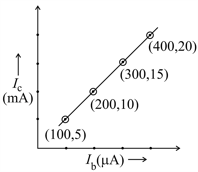Define beta current gain of the transistor.
Important Questions on Semiconductor Devices
The transfer characteristic curve of a transistor, having input and output resistance and respectively, is shown in the figure. The voltage and power gain, are respectively:

Given below are two statements:
Statement I : junction diodes can be used to function as a transistor, simply by connecting two diodes, back to back, which acts as the base terminal
Statement II: In the study of transistors, the amplification factor indicates ratio of the collector current to the base current.
In the light of the above statements, choose the correct answer from the options given below.
In transistor electrons enter the emitter in when it is connected to the battery. About electrons recombine with holes in the base. The current gain of the transistor is __________

